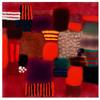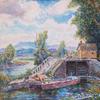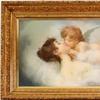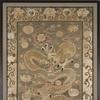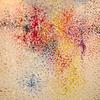Featured 19th Century Painter: FRANKLIN DEHAVEN (AMERICAN 1856 - 1934)
- July 17, 2020 10:16
New England Tonalist landscape painter Benjamin Franklin DeHaven was born in Bluffton, Indiana. Very little biographical information is available prior to 1886 when he had moved to New York City to study art, however, Frank DeHaven reportedly said that “when about 13 years of age he had an intense desire to paint landscapes.” In New York he studied under George Smillie, a member of the National Academy of Design, who painted in the style of the Hudson River School. Although influenced by this style, DeHaven painted predominantly in a low-key Tonalist style, an American adaptation from the French Barbizon School plein air artists, which emphasized the emotional effects of shadow and atmosphere. Large expanses of moody sky were often featured in his compositions, although his oeuvre included landscapes painted in a brighter, luminist style, also derived from the French Barbizon painters. Unlike his contemporaries, DeHaven never traveled to Europe to further his art studies and paint, perhaps he was content to paint the wild, still untamed vistas that the America had to offer. That he was in New York State in 1882 is documented by a painting of the Hudson River Valley, dated that same year. DeHaven painted mostly scenes of New England, spending summers in Tolland, Connecticut, but winters were spent in his Manhattan studio. Other paintings document that DeHaven traveled into the western United States, western New York/northwestern Pennsylvania, Florida, the American West and Alaska to paint. Franklin DeHaven was a member of the National Academy of Design; the Salmagundi Club (president 1926-1927); the National Arts Club; and the Allied Artists of America. He exhibited at the National Academy of Design (1886-1934); the Brooklyn Art Association (1886); the Pennsylvania Academy of the Fine Arts (1898-1906, 1921); the Boston Art Club (1892-1906); the Art Institute of Chicago (1889, 1904, 1914); the Salmagundi Club (NYC, 1900, 1901, 1925, prizes); the Pan-American Exposition (Buffalo, NY, 1901, prize); South Carolina Inter-State and West Indian Exposition (Charleston, 1902, silver medal); Louisiana Purchase Exposition (St. Louis, 1904, silver medal); Society of Independent Artists (NYC 1917; National Arts Club (NYC, 1921, prize), and Allied Artists of America (NYC, 1930, gold medal).







